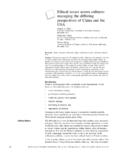Transcription of Introduction to International Organizational …
1 Introduction to International Organizational behavior Simon Dolan ESADE Ramon Llull University Tony Lingham Case Western Reserve University Price: Free 1. Abstract Fundamentals of International Organizational behavior by Simon L. Dolan and Tony Lingham This book is designed to provide historical and fundamental aspects or Organizational behavior so as to cater to the diversity of knowledge and related experience in the fields of psychology, sociology or business. This book is useful for college students who are taking their first course in Organizational behavior and who are interested in International business or management. About the Authors :- Simon L. Dolan - He holds an HRM / OB chair in ESADE Business School, which ranks today as one of the top 10 business school in the world. Tony Lingham - He teaches the LEAD program, conducts leadership development programs focusing on Experiential Learning, Learning Flexibility and Emotional Intelligence for top MNC executives in Case Western Reserve university.
2 Read more: Fundamentals of International Organizational behavior by Simon L. Dolan and Tony Lingham - CNET by-Simon-L-Dolan-and-Tony- #ixzz214qVAn6Y. Why Adopt a Textbook? Organizational behavior (OB) is the study of individual and group behavior in Organizational settings. OB looks at organizations as entities, the forces that shape them, and their impact on the members. The study of OB involves three levels within organizations: (1) Individual; (2) Group (or Team); and (3). Organizational 2. Preface ---------------------------------------- ----- 5 - --9. Chapter 1: What is Organizational behavior ? ---------------------------------------- ---- 10 - 45. Chapter 2: Understanding Individual behavior in Organizations ---------------------------------------- ---- 46 - 76. Chapter 3: Motivating People in a Global Environment ---------------------------------------- -- 77 - 106. Chapter 4: Managing Work Groups and Teams ---------------------------------------- - 107 - 141.
3 Chapter 5: Leadership and Executive Coaching: The Keys to Success ---------------------------------------- -- 142 - 181. Chapter 6: Enhancing Effective Communication in Organizations ---------------------------------------- -- 182 -211. Chapter 7: Managing Power and Conflict in the Workplace ---------------------------------------- -- 212 - 238. Chapter 8: Understanding Decision Making Processes in the International Arena ---------------------------------------- -- 239 - 267. Chapter 9: Managing Stress and Enhancing Well-Being at Work ---------------------------------------- -- 268 - 302. Chapter 10: Managing Change and Culture Reengineering : The ABC of Managing by Values ---------------------------------------- -- 303 - 340. Chapter 11: Managing Careers in Global Contexts ---------------------------------------- -- 341 - 371. Chapter 12: Managing Diversity and Cross-Cultural Issues ---------------------------------------- -- 372 - 403. Chapter 13: Emerging and Contemporary Themes in Global Organizational behavior ---------------------------------------- - 404 - 443.
4 3. Dedication Adela Maldonado -- my loving wife, my life-support and my source of Bonnie A. Richley -- the love of my life; co-creator of our dreams; and the true fusion of brains and beauty (in every possible way): God's greatest gift to Introduction to International Organizational behavior 4. Preface Having lived and navigated through various cultures around the world, we came to the decision to write a text book on the fundamentals of International Organizational behavior . Between the two of us, we have worked in South East Asia, Asia, Europe, the Middle East, Canada, the US, South America, and even conducted workshops in Africa. In this book, we have made conscious effort to include case studies or vignettes that are based on our experiences or experiences of others that we know or came into contact with in our work across different cultures. The inspiration to write this book came when both of us met at ESADE. Business School and were teaching courses on Organizational behavior to students that came from different parts of the globe and raised many issues that required us to relate our experiences in the global environment in the classroom.
5 We also ensured that this book covered influential theories such as Experiential Learning Theory that would help faculty and students focus on engaging in the process of learning. As such, this book has been written and designed for college students who are taking their first course in Organizational behavior and who are interested in International business or management. We have also designed this book to provide historical and fundamental aspects or Organizational behavior so as to cater to the diversity of knowledge and related experience in the fields of psychology, sociology or business. Pedagogical Features Many textbooks often attempt to be all-inclusive. Students find these complex texts daunting, and instructors may find them confusing and time-dated. In designing the chapters for the book we paid attention to creating a good process that will encompass the needs of the field and that of past experiences from faculty who have taught Organizational behavior or related courses: 1.
6 We began by including topics that each co-author deemed essential. 2. We then surveyed students and consulted colleagues, asking them to rank topics from a large menu of possibilities. Topics that were repeatedly high-ranked or considered important were revisited and incorporated into the chapters. On occasion, when we decided that the topic did not deserve a chapter on its own, we incorporated it into a chapter that would fit well and to also not affect the flow of the chapters as we have designed them. 3. Finally,we were very sensitive to the debates and discussions in International conferences dealing with IOB. issues and issues that were raised in classroom situations that we had to elaborate or relate to from our own work, consulting, training, and research experiences. 5. A Conscientious Blending at Various Levels The content is designed to blend the classic with the current; theory with practice; and International with the national or regional Chapters are integrated and ordered to flow naturally; yet, each is sufficiently self- contained to permit exclusion.
7 Material has been chosen to reflect our unique International perspectives and experiences. Design of Each Chapter Each chapter begins with a clear outline of what aspects are covered in the chapter to help students know what the learning objectives are. We then introduce the chapters and expand on the knowledge areas paying attention to the levels of headings so as to allow the text to "breathe" with the reader. Within each chapter we incorporate an International Organizational behavior in practice which we label "IOB in Practice" so as to allow students to engage with how such theories or knowledge is manifested in the International environment. Each chapter ends with a self-assessment exercise as well as one or more International mini cases connected with the chapter theme. Case studies in each chapter portray real-life International Organizational behavior or IOB situations in action. As students have to be able to relate to these experiences, these projects have been designed with them in mind.
8 Some are classics reprinted with permission from materials we had developed and published before, others were created by the authors of this book. We also include vignettes that are original contributions by IOB leaders in the field so as to inspire and help students know some of the interesting, exciting and vibrant work of some of the leaders in the field. These leaders include Henry Mintzberg, Edwin A. Locke, Edward Lawler III, Rosalie L. Tung, Abraham K. Korman, Cary L. Cooper, Edgar H. Schein, Nancy J. Adler, and Chris Argyris. Signposting Each Chapter We begin Chapter 1 with an Introduction to International Organizational behavior where we define the field of Organizational behavior ; the three different levels that represent this field that also makes its nature interdisciplinary; the historical foundations of the field and lead into the need to understand International Organizational behavior in today's work environment. We then provide a cursory overview of research methods that are used in this field to demonstrate its variety and depth in approaches and focus.
9 In Chapter 2 we focus on the individual level of Organizational behavior highlighting personality, attitudes, social perception and the attribution process, and the Theory of Experiential Learning and individual preferred learning styles. We included Experiential Learning in this text for two reasons: it is the most influential learning theory used in managerial and leadership development and it provides an understanding of the diverse ways in which 6. people learn which can be applied to the classroom environment. Chapter 3. goes on to highlight motivation theories and the relation between learning styles and motivation. We abstract upwards into the group (or team) level in Chapter 4 where we begin with the basic definition of group (or teams) and the importance of working in teams. Here we present the foundational work on teams leading to the most recent approaches to team learning and development. We believe that understanding what groups (or teams) are, how they function, learn, and develop can inform both faculty and students to create a nurturing (challenging and supportive) team environment in the classroom.
10 Chapter 5 introduces the meaning and importance of leadership and provides some of the influential theories of leadership that emerged from the 1920s. We also included the importance of understanding leadership development from a competency vantage point and how this approach has led to the emergence of executive coaching. In Chapter 6, we discuss the basic elements of the communication process, the different types of communication networks that exist within the Organizational environment and some of the obstacle to effective communication. We close this chapter by describing various methods to improve Organizational communication including how to create the right conversational spaces that is applicable to organizations and the classroom. This flows into a discussion of managing power and conflict in Chapter 7. where we include understanding "power" as a concept, the various manifestations of power and strategies to use power effectively.





